Friday, 27 February 2009
Interim deadlines for Thriller
Animatic Storyboard to be completed by the first lesson of the w/c 23rd Feb
Initial Filming to be completed by the first lesson of the w/c 16th March
Initial Editing to be completed by the first lesson of the w/c 23rd March
Final Filming and Re-edit to be completed by the first lesson of the w/c 6th April
Evaluation to be completed by the first lesson of the w/c 20th April
Final Adjustments to be completed by the last lesson of the w/c 27th April
FINAL DEADLINE: THURSDAY 30th APRIL 4PM
Thursday, 26 February 2009
Risk Assesment
Numerous risks can be pointed out during the filming of our project, these include:
1) The breaking of our sugarglass
2) Dangers of filming around river
3) Transportation of equipment to further destinations
4) Electric equipment being used outdoor
5) Possibility of it raining
We will ensure our safety and our equipments safety by doing the following things:
1) Break it in a controlled environment with no unnessesary people in the room, we will use safe surroundings that has space, also we will ensure that our broken sugar glass can easily be cleared up.
2) We will film the water sequence with a reasonable distance between us and the water, this will prevent us slipping in or damaging equipment with water.
3) When transporting equipment we will ensure we use the appropriate carriers, for example for the cameras we will use the allocated bag that come with them, when travelling on the bus with equipment we will ensure it’s safety by keeping it at our side.
4) We will ensure all wires are tooked away and any lighting will be switched off when not in use at the mains.
5) We will check the weather forcast before setting out to film and also make sure we have waterproof carriers with us, so we can store the equipment if it does start to rain.
Deciding on actors
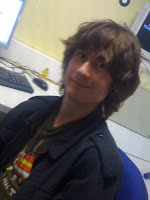
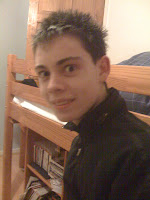
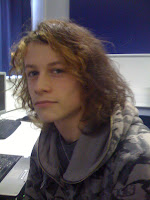
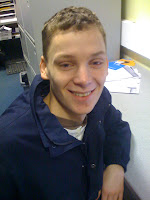
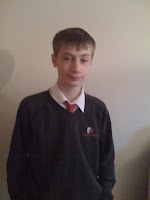

We chose the actor below because he looks relativley vunerable, young and is a reliable friend. Scott also has a GCSE in Drama, so this will be a valuable asset to our sequence. We will work around Scott's availability as to when we film.
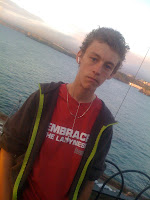
Designing the Costume
Planning and Developing
Monday, 23 February 2009
Deciding locations
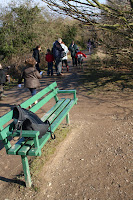
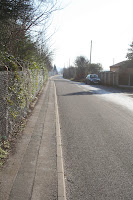
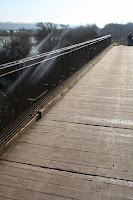

Sunday, 22 February 2009
Storyboarding the idea
Further development on idea: Timeline
Further development on idea: Brainstorm
 Using this brainstorm, we will create a time-line. We are going to make little slips of paper, and write each shot on each piece. We can then easily re-arrange the order and this will aid us when making the storyboard.
Using this brainstorm, we will create a time-line. We are going to make little slips of paper, and write each shot on each piece. We can then easily re-arrange the order and this will aid us when making the storyboard.
Tuesday, 17 February 2009
Audience Research
Here is our completed questionnaire.
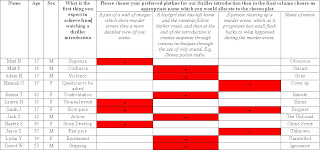
As you can see the most popular idea is the sequence where a child has run away from home, and for this reason we will continue developing only this idea. We now also have many ideas on what people expect to be achieved in an opening sequence. We will consider all these suggestions when further developing and brainstorming our idea. The main convention we need to include is the creation of suspense. Two actors/actress' will be needed in this opening sequence.
I conducted further audience research to get a broader idea of who watches thrillers. We can then target our audience more effieciently. From conducting internet research I found that an equal number of males watched thriller compared to females. This doesn't conform to steryotypes as you would expect more males to watch thrilers, due to the conventions used. Therefore we will try to appeal to both male and female audience.

I also found that the 35% of the people that watch thrillers are aged 14-24; as shown by this graph. We will therefore aim our thriller at this age range.
http://www.valmorgan.com.au/au/audiences/profiles/thrillers/
Research into Thriller genre and industry
In general thrillers rate quite high in the most profitable films. The most famous example being The Blair Witch Project (1999) Daniel Myrick, Eduardo Sanchez. This film had a relatively low budget of approximately $35000 and made a profit that was 7107 times the initial investment reaching a total of $248,660,000 making it the most profitable film of all time. The success of the film was in the production and marketing. The actors were only given a vague description of the plot and therefore acted in such a way that the audience perceived it as a real documentary. This enticed the audience and helped to create narrative enigmas. I also aim to entice my audience using suspense and narrative enigmas.
Thrillers also rate quite high in the top favourited films of all time. The Godfather (1972) Francis Ford Coppola rates second in IMDB Top 250 Movies, and The Godfather, Part II (1974) Francis Ford Coppola rates in third place. The Dark Knight (2008) Christopher Nolan and Star Wars: Episode V - The Empire Strikes Back (1980) Irvin Kershner also rate in the top 10 films.
Sunday, 15 February 2009
Detailed Analysis of opening sequence of Thrillers
The Godfather (1972 Francis Ford Coppola)
Whilst the production company is introduced, and the title is shown, traditional Italian non-diegetic music is played. The slow violins create an eerie yet intriguing atmosphere. The title fades to the opening shot. The music stops as the character first speaks. As the character talks about how is beloved daughter was hospitalised in a violent attack, the camera zooms out ever so slowly. At first the audience think he is talking directly to the camera, the room is dark and the background is blurred so we don't realise anyone else is present. As the character becomes upset, the protagonist (the Godfather) comes into shot. At this point we realise there is more than one person in the room, and that the initial character is pleading for help, to get revenge. The revenge theme and the insight to the plot, engage the audience and help to create a narrative enigma.
The dark setting and the early establishment of a revenge theme are typical conventions of a thriller, and the unfamiliar surroundings is also typical of opening sequences in a thriller. I will consider these conventions when planning the opening sequence of my own Thriller.
The Godfather: Part II (1974 Francis Ford Coppola)
The sequel to the original film starts very much the same as the first, in a dark unclear environment. The section is accompanied by a similar eerie non-diegetic tune. It then however cuts to an extreme long shot of an outdoor scene where people begin to cross a desert-like environment. This scene is accompanied by a different tune, which is not as eerie, yet however has a sad feel to it. Text is displayed on top of the shot, and explains how the protagonist's father was murdered by the local Mafia and how is brother had sworn revenge on the murderers and disappeared into the hills. As the text fades, we cut to a closer shot and realise that this is the funeral of the late father.
Gun shots are heard and the characters disperse, it is quickly revealed that brother that swore revenge, was shot by the Mafia. Again this creates narrative enigmas and keeps the audience interested. It also derives sympathy for the mother and protagonist.
The theme of revenge also occurs in the opening sequence, just like it did in the previous film. Questions are quickly raised, and these keep the audience interested. I also aim to raise questions and create suspense in my opening sequence to keep the audiences interest.
Lucky Number Slevin (2006 Paul McGuigan)
As the camera pans across a notepad, the names of the director and actors etc appear. Non-diegetic eerie harp music accompanies the sequence. As well as this other noises can be heard. We can hear what sounds like a sports commentator uttering numbers of the players, police sirens, a news report on a shooting, police radios and other various day-to-day sounds. The notepad shot then fades to a medium shot of what appears to be a Hotel room, a telephone is the focus of the shot, however the shot quickly fades to an unusual shot of a lift and then this shot dissolves to a medium shot of a man walking through a multi-storey car park to his car. As the man is about to unlock his car door he is shot twice with a silenced gun. The killer then picks up the victim's folder and walks away. Suspense is built because we never see the killers face. The silenced gun implies that the killer is stealthy and that the man was targeted specifically. The shot then cuts to the notepad again and then to another scene where the killer commits murder again, and again takes the victim's folder. Just like the first murder, it is stealth like and we don't see the killers face. This further derives suspense and engages the audience.
Tuesday, 10 February 2009
Brainstorming ideas
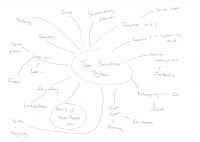 To start our project going, Luke and I decided we would brainstorm lots of initial ideas on what our Thriller could be like. To do this we made a mind map.
To start our project going, Luke and I decided we would brainstorm lots of initial ideas on what our Thriller could be like. To do this we made a mind map.Once finished we had an idea on what we wanted to do. We then began to think about how we could
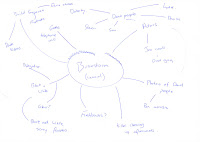 include typical conventions to further our ideas. We selected three of our ideas and thought about them in more detail. We also constructed a questionnaire asking other people's opinion and what they thought of our initial ideas. We will carry out this questionnaire next lesson. Below is another mind map we made where we jotted down our further ideas. Next lesson we will focus our attention on audience research and research into Thrillers.
include typical conventions to further our ideas. We selected three of our ideas and thought about them in more detail. We also constructed a questionnaire asking other people's opinion and what they thought of our initial ideas. We will carry out this questionnaire next lesson. Below is another mind map we made where we jotted down our further ideas. Next lesson we will focus our attention on audience research and research into Thrillers.
Monday, 9 February 2009
Group decided
Conventions of a Thriller
Camera angle and Movement Conventions:
- Quick cuts and camera angle changes
- Pans of dark environments
Editing Conventions:
- Quick fast paced cuts during action scenes
- Use of negative editing to derrive suspense
Mise en Scene Conventions:
- Use of shadow
- Mirrors which shows the antagonist's reflection
- Spiral Staircases
- Dark Lighting
- Costume reflects victim's state. Torn clothes etc.
Sound Conventions:
- Sudden eerie chimes to create suspense
- Eerie echos
- Exaggerated sounds, e.g. loud footsteps
Other Conventions of a Thriller:
- Crime is often the narrative
- There is often a theme of identity
- Protagonist with a flaw which is exploited by the antagonist
- Complex narrative
- Usually many plots within one main narrative
- Sympathy is derrived for the victim
Wednesday, 4 February 2009
Research: Analysis on Thrillers
I watched the opening sequence to two Thrillers; The Others (2001 Alejandro Amenabar), and Memento (2000 Christopher Nolan). The Others, is a story about a mother (Nicole Kidman) and her two children set in a large creepy mansion. Strange things start to happen in the house, when the maids and cook etc disappear. The children then start to see ghosts. But are they ghosts? Memento is about Leonard (Guy Pearce) seeking revenge on the man who murdered his wife. The twist however is Leonard can’t remember any new memories after 15 minutes, his only memories are those previous and including the night his wife died. Both films include typical conventions of a thriller, below are the conventions I found in both opening sequences.
The Others:
- Low naturalistic lighting creates gives the mansion a dominant scary feeling.
- Lots of Shadow, makes the setting seem creepy. (In the film, the two children are allergic to excessive light, this is another reason for the dim settings)
- Quick camera angle changes derives sense of panic
- Quick cuts derive sense of panic
- Creepy non-dietetic chimes make you jump and help you to understand the characters state of panic
- Fast paced music engineered to create panic
Memento:
Chronological work - the order of events are mixed up in order to keep you thinking.
Use of Flashback – keeps the viewer thinking and derives suspense
Features a typical “hard” man, whom is familiar to danger
Low naturalistic light derives eerie feeling
Use of black and white – distinguish different time periods and also derives eerie feeling and suspense
Sudden non-diegetic chimes create suspense
Violent resolution to film – Typical convention of a physiological thriller
Preliminary Task: Analysis and Critique
Preliminary Task: Editing
We were shown how to use the program and some top techniques before we edited our own sequence.
There are four main windows in Adobe Premiere Pro used for editing. These are the Project Browser, the Preview box, the Timeline, and the Toolbar. We were shown how to use each window and the main tools, including capturing footage, setting in-points and out-points and editing using the Timeline. We also learnt how to use add titles, and video effects/transistions.
We each had a go at editing our sequence so that we each got practice at doing it. It took us little over an hour to do so, and we are all please with our final film. There are however somethings we can improve on when making our thriller. Please see Preliminary tasks: Analysis and Critique, to read the analysis.
Preliminary Task: Filming
Before filming we were taught certain techniques on how to film efficiently. Below are the key points.
- Treat the cameras with respect in order to avoid damage
- Use a cloth to clean the lens
- Use a tri-pod to film in order to keep the camera steady
- Turn off steady-shot mode
- Set the audio level to 16-bit not 12-bit
- Use pre-roll and post-roll techniques to make sure all the footage is captured. (This can be later cropped in the editing stage)
- Don't point the lens at the sun
- Keep the action in the centre of the screen
- Set white balance
- Adjust zoom to alter focus
White balance: Before filming, hold a piece of paper where you intend to act. Set the camera to white balance, and zoom in on the paper and press "OK". Do this to let the camera know what is actually white in the area you are filming, from this it can adjust all the surrounding colours to their natural colour.
Filming was a success. It took approximately 45mins to film our 30 second piece. There were no particular obstacles to overcome, and we filmed what was planned in our storyboard.
Preliminary Task: Storyboard
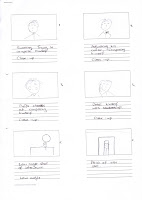
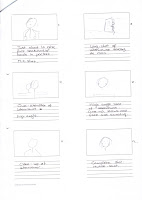
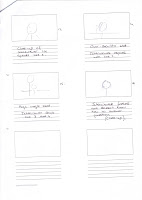 We then made a storyboard and planned out each shot in detail. Not only did we do this for organization, but it also helped us to think about what type of shot we needed, and this enabled us to think about what effect each angle/movement had on the audience. It also helped us to understand the 180 degree rule and how to avoid this problem when filming.
We then made a storyboard and planned out each shot in detail. Not only did we do this for organization, but it also helped us to think about what type of shot we needed, and this enabled us to think about what effect each angle/movement had on the audience. It also helped us to understand the 180 degree rule and how to avoid this problem when filming.
Preliminary Task: Costume
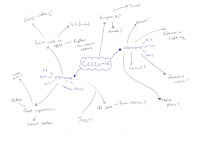 The next stage was to think about possible costumes. To do this we made another brainstorm.
The next stage was to think about possible costumes. To do this we made another brainstorm.After considering many ideas, we decided that the interviewer would be dressed smartly and the interviewee tries to make an effort to look smart, however has improperly ironed clothes and is more smart-casual. We chose these costumes to give the audience an indication of the personality of the characters.
Preliminary Task: Location and Props
Preliminary Task: Brainstorm
The Preliminary Task
My group consisted of Sam Gibbons, Holly Costema, Ryan Boyington, and myself.
We started by brainstorming ideas for our 30 second sequence. Above is our brainstorm.













